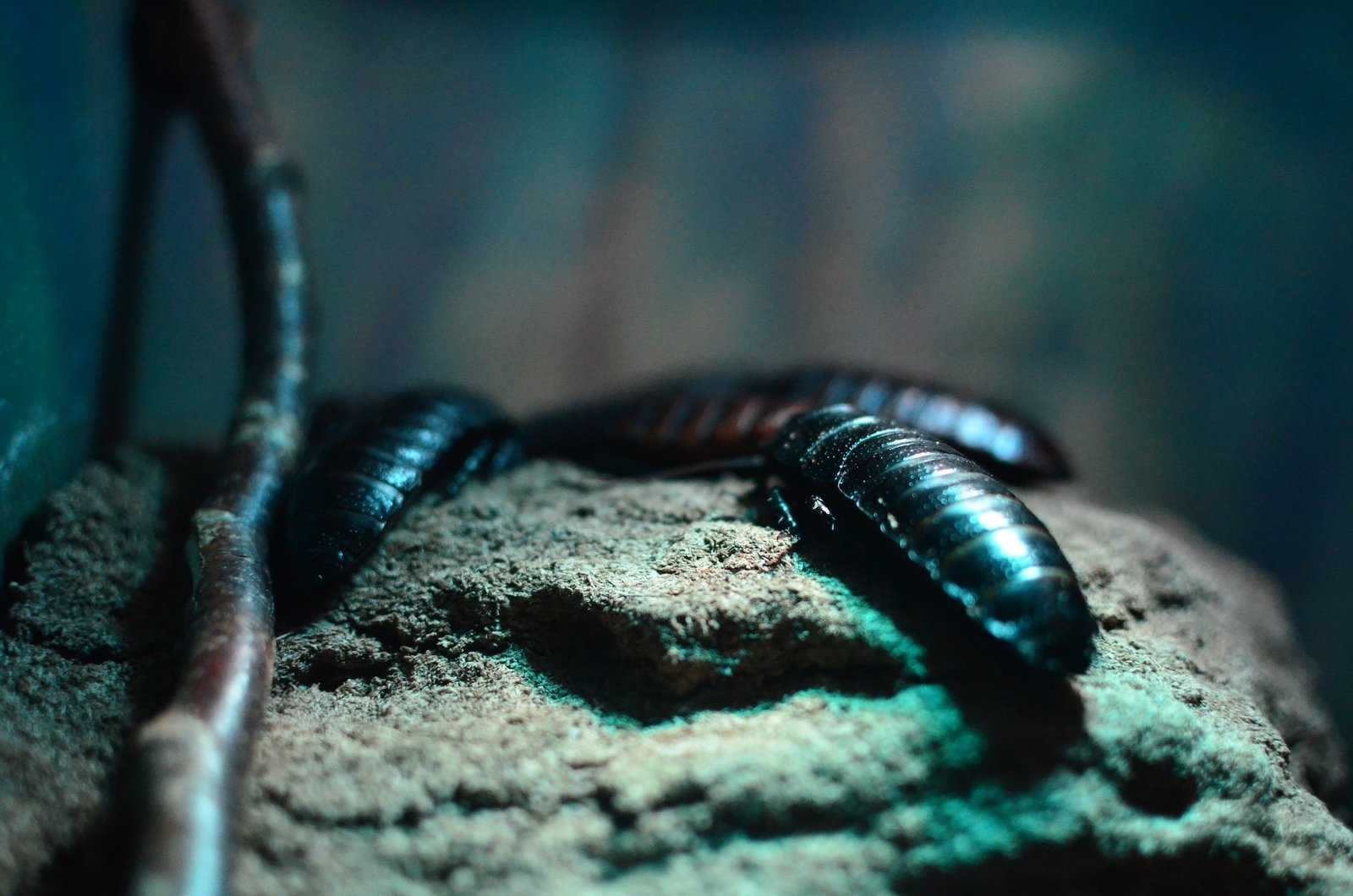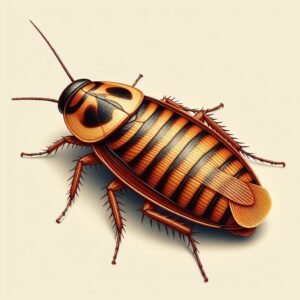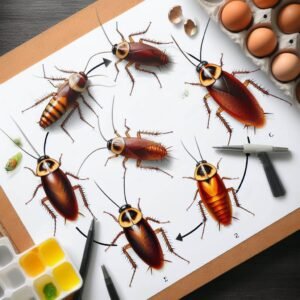A sea cockroach, also referred to as an isopod, is a type of crustacean that has adapted over time to live primarily in aquatic environments.
Unlike regular cockroaches that most people are familiar with that thrive on land, sea cockroaches have developed specialized traits and characteristics that allow them to live and thrive in both saltwater and freshwater ecosystems.
To picture what a sea cockroach looks like, imagine a crab, shrimp, or lobster reduced down to its simplest form. Sea cockroaches have protective segmented plates covering their bodies and many sets of legs that aid in swimming, grasping onto rocks, or capturing bits of food. Their bodies are elongated and flattened, allowing them to easily squeeze into tight crevices and rock cracks.
There are over 10,000 species of sea cockroach spanning the entire globe and occupying nearly every sort of aquatic ecosystem imaginable. So whether swimming around in the crashing waves along a beach shoreline or crawling across the deepest most cavernous regions of the ocean floor, sea cockroaches have found a way to survive and flourish.
Types of Sea Cockroaches and Where They Live
There are two primary classifications of sea cockroaches with dozens of distinct species – the common shore dwelling sea cockroaches and the larger giant isopods that inhabit deeper ocean floors.
Common Shore Isopods
The small isopods commonly found scurrying across coastal rocks, wharfs, and shorelines typically fall under two main categories – the Ligia exotica and Ligia oceanica.
Ligia exotica sea cockroaches are most commonly found throughout tropical and subtropical oceans waters. They seek refuge from the crashing waves and coastal storms by hiding themselves under rocks, shells, man-made debris, or lodging themselves into shore cracks and crevices.
Ligia oceanica is an almost identical species that occupies similar near-shore habitats but is instead native to the more frigid seas and coasts of Northern Europe. While these shoreline isopods span the globe in coastal waters, they are relatively small ranging in size from roughly 0.5 inches to 1 inch when full grown.
Giant Deep Sea Isopods
In the cold eternal darkness of the deep ocean floor reside some of the most alien-like isopods on our planet. The giant deep-sea isopods include the more famous Bathynomus giganteus along with other lesser-known genera like Pautomus, Alicella, and Cyllosaurus. Instead of mere inches in length, these monstrous sea cockroaches can grow larger than a human foot long!
Deep sea isopods live at extreme depths ranging from 1,300 feet to over 7,000 feet below the surface. They prefer depths with cold temperatures, high pressures, and little to no light. These giant isopods crawl along the sea floor in these dark abyssal plains seeking fallen organic matter that filters down from above.
It is in these cold, nutrient-rich waters that giant deep-sea isopods can reach epic proportions, growing as large as 16.5 inches long and weighing up to 4 pounds. To reach these shocking sizes, giant isopods can live upwards of ten years gorging themselves every once in a while a wandering deep sea isopod will come across the carcass of a fallen whale, shark, or fish and embark on a years-long feeding frenzy, ballooning its size like nothing else in its natural habitat ever could.
Sea Cockroach Scientific Classification
From a scientific standpoint, sea cockroaches belong to the subphylum Crustacea and the order Isopoda. Within this order there are dozens of smaller subgroups and families that the 10,000+ species get further categorized under such as the Asellota, Phreatoicidea, Oniscoidea, Valvifera, and others. So when talking scientific names, most sea cockroaches will have Isopoda included in their full taxonomic hierarchy.
Detonida and Asellota are two lesser orders that occasionally get used when specifically talking about the giant deep-sea isopods or other specialized varieties. But in general, if you know that an organism falls under Isopoda – then you’ve correctly identified the fact that it is indeed a sea cockroach.
How big is a sea cockroach?
The common shore-dwelling varieties are very small – usually between 0.5 inches to 1 inch (1.25 cm to 2.5 cm) in length. Generally under 1 inch.
The giant deep-sea species can get much much larger. For example, the Bathynomus giganteus grows to between 12 to 20 cm (4.7 inches to 7.9 inches) long. The very largest deep sea isopods found have been reported at over 16 inches (40 cm) in length and weighing around 4 pounds (1.8 kg). I know it sounds bizarre to some but that is the fact and I’m not intended to scare you off.
To summarize:
- Shore species: Typically under 1 inch long
- Deep sea species: Range greatly in size up to 16+ inches long
So while the small isopods scattering around the water’s edge are quite tiny, their abyssal relatives in the deeps of the oceans can reach impressive and even scary sizes of over a foot long. The deep sea gigantism allows these specialized scavenging crustaceans to grow to the size of a small mammal.
Hunting for Your Own Sea Cockroaches
For those of you who are intrigued to catch your own sea cockroaches, shoreline species can rather easily be collected from coastal aquatic environments around the world. One simply needs to search in the intertidal zone and flip over rocks, wood, metal debris, shells, barrels, or virtually any object that serves as suitable cover on a beach.
Chances are good that one to several small isopods from the Ligia genus will be found hiding or at least quickly scurry away if their covering gets removed and pulled away. Carefully dig through sand and maze your fingers through rocks and you’ll likely find shoreline sea cockroaches rather readily anywhere the ocean meets land.
As for the giant deep-sea varieties, leave this to the trained deep-sea marine biologists in submarines capable of reaching such crushing depths! Recreational scuba diving only safely goes to depths of 100-130 feet on average. Leave the extreme depths where giant isopods crawl about to the professionals!
The Diets and Feeding Habits of Sea Cockroaches
Feeding mostly as scavengers on dead plant and animal matter, sea cockroaches play a key role in aquatic environments helping recycle nutrients and serving as a food source for other organisms higher up the food chain. Their versatile diets allow them to feed on:
- Algae and microbes coating underwater surfaces
- Decaying plants and leaves
- Dead fish, whales, turtles, and ocean predators
- Animal feces and discarded bits of organisms
- Slow moving small worms, eggs, larvae, and creatures
Shoreline sea cockroaches have been observed congregating by the thousands on beached whale carcasses showing their nature to capitalize on sporadic events like this to feast. This allows for periods of faster growth and reproduction – taking advantage of a temporary abundance of meat before returning to scrape by on algae and bits of debris.
The same holds true for giant deep-sea isopods. With their extreme lifespan lasting decades, these patient scavengers will crawl about mostly inactive until coming upon the rare bounty like a sunk whale corpse. Then utilizing razor-sharp jaws, giant isopods voraciously tear chunks of flesh off the carcass to feed – often burrowing partially inside to safely dine.
Interesting Facts About Sea Cockroaches
Beyond their alien appearance and variety in sizes, here’s a collection of additional fascinating facts about these unique crustaceans:
- Sea cockroaches exhibit brooding behavior to care for eggs and offspring after initially hatching. Females carry pouches of eggs and then carry hatched babies on their backs until large enough to independently survive.
2) Isopods were some of the earliest crustaceans to evolve over 300 million years ago during the Carboniferous period when aquatic and terrestrial varieties emerged.
3) Special glands near their mouths allow them to drink freshwater from the surface film – critical for intertidal species that get stranded by the tides.
4) Their flattened bodies and shapes allow isopods to take advantage of tight hiding spaces like cracks that other larger organisms couldn’t penetrate into.
5) Some isopods species have shown remarkably tolerance to cold temperatures – including Antarctic varieties that have special adaptations like glycerol to act as a natural antifreeze down to freezing subzero conditions.
is sea cockroach dangerous?
No, sea cockroaches (isopods) are generally not considered dangerous to humans.
- They cannot bite or sting – Isopods have no venom and their small mouths/jaws cannot inflict any harm to humans. The larger species may give a harmless pinch with their jaws if handled.
- They do not spread diseases – There are no known disease agents transmitted by isopods or cases of them causing infections, even if handled.
- The small intertidal species are harmless if stepped on. Even the giant deep sea varieties would not pose a threat if encountered by divers or submarines.
- While looking a bit intimidating, giant deep sea isopods are slow creatures that lack any serious defense mechanisms. Their size can give them a bit of a frightening appearance, but they remain docile gentle giants.
- Some marine biologists even handle giant isopods with their bare hands without issue during deep sea exploration and research projects.
So while the idea of gigantic 16-inch long “sea cockroaches” crawling about on the ocean floor might sound scary, isopods do not actually pose any real danger or health hazard to people. They are harmless scavengers going about their existence eating dead matter. So sea cockroaches get a bad reputation from their name and look alone – in practice, they are benign creatures.
What eats sea roaches?
Sea roaches, or isopods, occupy an important niche in aquatic food chains and have a number of predators that frequently prey on them, including:
Fish: Many small reef fish and bottom-dwelling species will eagerly feed on smaller isopods wandering the seafloor. Flounder, sole, blennies, gobies, and lizardfish are examples of fish that consume isopods.
Larger Crustaceans: Crabs, lobsters, and shrimp will sometimes prey on marine isopods, mainly the smaller intertidal species versus the giant deep sea ones.
Aquatic Birds: Seabirds near shorelines like gulls, terns, and herons will eat isopods. The marine isopods provide a valuable food source for coastal bird species.
Intertidal Predators: In tide pools and coastal zones, isopods must be wary of other predators like the marine ancestors of octopuses, cuttlefish, sea stars, and other echinoderms.
Humans: Some cultures even eat certain larger isopod species, like the giant deep-sea Bathynomus giganteus which is occasionally eaten in Japan.
While isopods have diverse anatomical defenses like their hardened segmentation and ability to curl into a defensive ball, they still have their fair share of predators in nearly all aquatic habitats from shallow waters to deep seas. Their great abundance though ensures they remain well populated as an important part of oceanic food webs around the world.
Is crayfish the sea cockroach?
No, crayfish and sea cockroaches (isopods) are related crustaceans but they are different species with some key differences:
- Crayfish are freshwater animals, while isopods are mainly marine and live in saltwater oceans, coastal areas, etc. Some exceptions exist on both sides though.
- Crayfish have large claws/pincers as their front legs and 2 additional pairs of walking legs. Isopods don’t have the large claws – just 7 pairs of similar leg types used for grasping food and locomotion.
- Crayfish have longer antennae and tails than isopods, giving them a different silhouette. Isopods have flatter, more oval bodies.
- There are around 540 species of crayfish compared to over 10,000 species of isopods. So while related in the same crustacean subphylum, they represent very distinct groups of animals.
- Typical sizes are different too – most crayfish don’t surpass 6-8 inches long, while some giant deep sea isopods can reach lengths of 16+ inches.
So in summary, while they are both crustaceans and share an aquatic existence similarities like segmented exoskeletons, crayfish, and sea cockroaches have marked visual and physiological differences that make them distinct types of animals rather than the same. Calling a marine isopod a “sea cockroach” is just a nickname – literal crayfish don’t qualify for this label in taxonomy.
Conclusion
For their sheer diversity, abundance, and global distribution – not to mention their alien appearance – sea cockroaches truly are remarkable survivors and important ecological organisms. Hopping across rocks along the shore or crawling along the deepest most remote hidden surfaces of the ocean floor, over 10,000 species of isopods can be found distributed across the waters of our world from equatorial to polar regions.
So next time you’re beach combing or happen to catch a documentary highlighting strange deep sea creatures, keep an eye out for these unique crustaceans. Who knows, you might just get lucky and spot a bizarre looking isopod or sea cockroach scurrying by! They are always busy recycling nutrients and serving key roles in maintaining properly balanced aquatic ecosystems.





